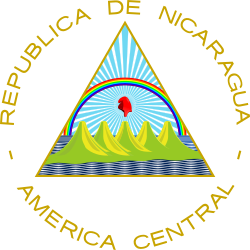
Central America is commonly said to include Guatemala, Belize, El Salvador, Honduras, Nicaragua, Costa Rica, and Panama. This definition matches modern political borders. Central America begins geographically in Mexico, at the Isthmus of Tehuantepec, Mexico's narrowest point, and the former country of Yucatán (1841–1848) was part of Central America. At the other end, before its independence in 1903 Panama was part of South America, as it was a Department of Colombia. At times Belize, a British colony until 1981, where English instead of Spanish is spoken, and where the population is primarily of African origin, has been considered not part of (Spanish-speaking) Central America.

The Federal Republic of Central America, initially known as the United Provinces of Central America, was a sovereign state in Central America that existed between 1823 and 1839/1841. The republic was composed of five states, and a Federal District from 1835 to 1839. Guatemala City was its capital city until 1834, when the seat of government was relocated to San Salvador. The Federal Republic of Central America was bordered on the north by Mexico, on the south by Gran Colombia and on its eastern coastline by the Mosquito Coast and British Honduras, both claimed by the federal republic.
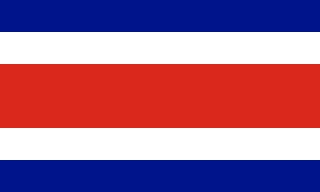
The national flag of Costa Rica is based on a design created in 1848 and consists of two blue stripes, two white stripes, and a central red stripe which is twice as wide as each of the other four. The civil flag omits the coat of arms seen on the state flag, since the state variant is only permitted to be used by the government.
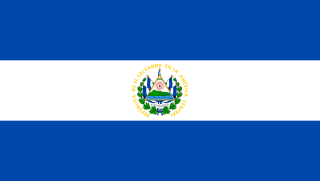
The flag of El Salvador features a horizontal triband of cobalt blue-white-cobalt blue, with the coat of arms centered and entirely contained within the central white stripe. This design of a triband of blue-white-blue is commonly used among Central American countries. The country's flag is one of the few that currently use the color purple, due to the rainbow in its coat of arms.

The flag of Honduras consists of three equal horizontal stripes of cyan, white and cyan, with five cyan stars in a quincuncial pattern at the centre of the middle stripe. The two outer bands represent the Pacific Ocean and the Caribbean Sea, and also represent the blue sky and brotherhood. The inner band represents the land between the ocean and the sea, the peace and prosperity of its people, and purity of thoughts. The five stars represent the five nations of the former Federal Republic of Central America and the hope that the nations may form a union again.

The flag of Nicaragua was first adopted on September 4, 1908, but not made official until August 27, 1971. It is based on, and inspired by, the flag of the Federal Republic of Central America and flag of Argentina.

The national emblem of the Democratic Republic of the Congo has changed several times since 1997. The current one was introduced in 2006 and depicts a leopard head, surrounded by an elephant tusk to the left and a spear to the right. Below are the three words which make up the national motto: Justice, Paix, Travail. It was adopted on 18 February 2006 by President Joseph Kabila.

The official coat of arms of the Republic of Costa Rica was designed in 1848, with modifications in 1906, 1964, and 1998. The latest change was the addition of smoke to distinguish the three volcanoes.
This armorial of sovereign states shows the coat of arms, national emblem, or seal for every sovereign state. Although some countries do not have an official national emblem, unofficial emblems which are de facto used as national emblems are also shown below.

The coat of arms of Portugal is the main heraldic insignia of Portugal. The present model was officially adopted on 30 June 1911, along with the present model of the Flag of Portugal. It is based on the coat of arms used by the Kingdom of Portugal since the Middle Ages. The coat of arms of Portugal is popularly referred as the Quinas.
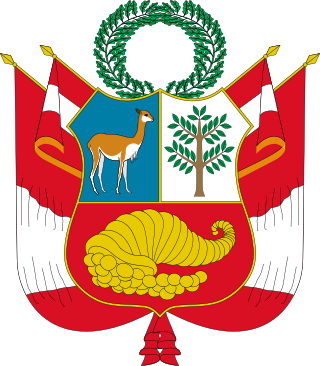
The coat of arms of Peru is the national symbolic emblem of Peru. Four variants are used: the coat of arms per se, the National Coat of Arms, the Great Seal of the State, and the Naval Coat of Arms.
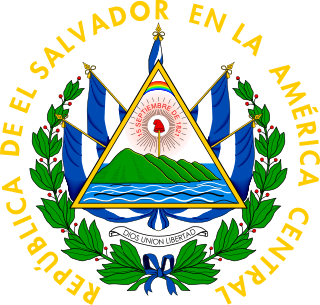
The coat of arms of El Salvador has been in use in its current form since 15 September 1912.
National symbols of Nicaragua are the symbols that are used in Nicaragua and abroad to represent the country and its people.

The following outline is provided as an overview of and topical guide to Nicaragua:
The Central America-4 passport is a common-design passport issued by the Central America-4 Border Control Agreement member states. Although the design had been in use by Nicaragua and El Salvador since the mid-1990s, it became the norm for the CA-4 in January 2006. The main features are the navy blue cover with the words "Centroamérica" and a map of Central America, with the territory of the issuing country highlighted in gold. Costa Rica, not a C-4 Agreement member, also uses a passport with the inscription "América Central", retained from the Federal Republic of Central America and included in its coat of arms. Despite their similar appearances, passports from each of the C-4 member countries do not have equal mobility rankings. El Salvador's passport ranks 36th on the Henley visa restrictions index and allows visa free or visa on entry access to 136 countries and territories, while Nicaragua's passport ranks 42nd and allows access to 128.

The current coat of arms of Guatemala was adopted after the 1871 Liberal Revolution by a decree of president Miguel García Granados. It consists of multiple symbols representing liberty and sovereignty on a bleu celeste shield. According to government specifications, the coat of arms should be depicted without the shield only when on the flag, but the version lacking the shield is often used counter to these regulations.
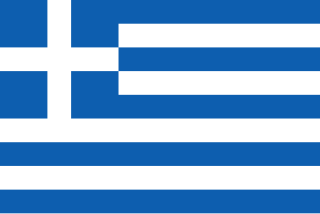
The national colours of Greece are blue and white.
The Commander-in-Chief of the Army is the professional head of the Armed Forces of the Republic of Nicaragua.

From January 1822 to July 1823, the Captaincy General of Guatemala, a former Spanish colony, was controlled by the First Mexican Empire, and briefly, the Supreme Executive Power—the provisional government that succeeded Mexican imperial rule. The captaincy general consisted of the provinces of Chiapas, Costa Rica, El Salvador, Guatemala, Honduras, and Nicaragua—the six southernmost provinces of the Mexican Empire. The incorporation of Central America brought Mexico to the height of its territorial extent.
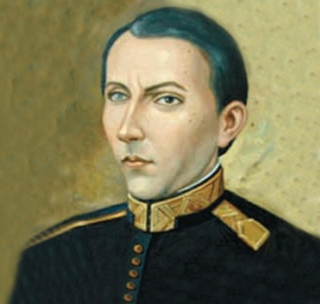
José Anacleto Ordóñez Bermúdez (1778–1839), also known as Cleto Ordóñez, and nicknamed "El tuerto Ordóñez" by his detractors, was a liberal Nicaraguan soldier, politician and prominent Central American unionist who served as de facto Supreme Chief of Nicaragua from August 1824 to 4 January 1825.
